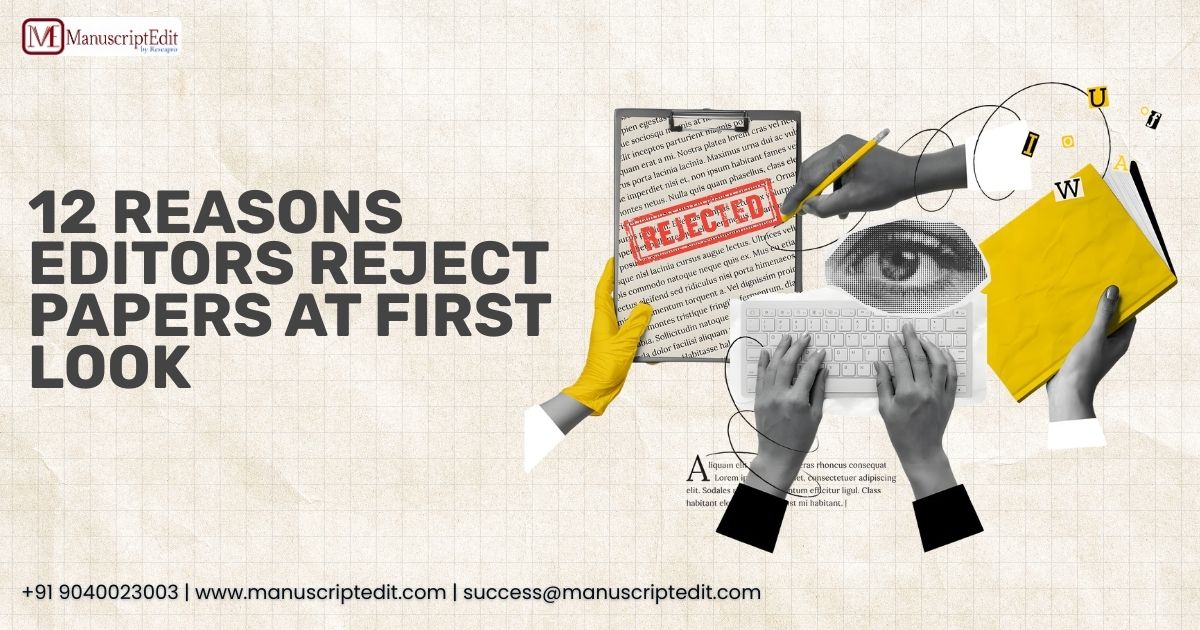Few moments are more disheartening for an author than receiving a desk rejection. Imagine investing months and years of effort into a study, only to be told your manuscript won’t even make it to peer review. The good news is that most desk rejections can be avoided.
In this blog, we’ll unpack the 12 Reasons Editors Reject Papers at First Look, backed by guidance from publishers and integrity organizations. As a bonus, we’ll share a free Pre-submission Red Flags Checklist (PDF) to help you catch problems early.
Table of Contents
How Editorial Triage Works
When you submit your paper, the editor-in-chief or an associate editor performs a quick “fit check.” This stage, often called editorial triage. The editor scans for noticeable problems:
- Is the manuscript within the journal’s aims and scope?
- Does it follow the author guidelines?
- Is the language clear enough for readers and reviewers?
- Does it raise any ethical concerns?
If red flags appear here, the manuscript is desk-rejected—saving reviewers’ time, but leaving authors frustrated.
The 12 Red Flags (and How to Fix Them)
Editors tend to cluster rejection triggers into four categories: Fit & Format, Quality & Contribution, Ethics & Integrity, Policy & Process.
Fit & Format
- Scope mismatch – Submitting to the wrong journal is the most common cause of rejection. Fix: Study the journal’s aims & scope and recent articles.
- Article type mismatch – Sending a case report to a journal that only accepts original research is a non-starter. Fix: Confirm acceptable article types in the guidelines.
- Ignoring author guidelines – Missing word counts, wrong reference style, or absent sections frustrate editors. Fix: Always double-check the instructions for authors.
Quality & Contribution
- Lack of novelty or impact – If your study doesn’t clearly advance the field, editors may pass. Fix: Highlight what’s new and why it matters.
- Weak methods clarity – Vague methods signal unreliability. Fix: Provide transparent, reproducible detail.
- Poor language quality – Clarity matters. Fix: Consider professional editing if English isn’t your strength.
- Outdated references – Leaning on old sources suggests the study is behind the field. Fix: Include recent, relevant citations.
Ethics & Integrity
- Missing ethics approval – For human/animal studies, ethics board approval is mandatory. Fix: State IRB/IEC approval details.
- Plagiarism or text overlap – Editors routinely check for similarity. Fix: Use plagiarism tools and rewrite overlaps.
- Image integrity issues – Manipulated or duplicated figures raise red flags. Fix: Provide raw data when required; follow COPE’s image manipulation guidance.
- Data availability gaps – Increasingly, journals demand data sharing. Fix: State where and how your data/code is available.
Policy & Process
- Duplicate submission – Submitting the same manuscript to multiple journals breaches policy. Fix: Submit to one journal at a time and wait for a decision.
Quick Self-Audit (Before You Click Submit)
Before sending off your paper, ask yourself:
- Does my study fit the journal’s aims & scope?
- Have I followed author guidelines word-for-word?
- Is the article type acceptable?
- Does my paper show novelty and clear impact?
- Are my methods transparent and reproducible?
- Is the language polished and professional?
- Are my references up to date?
- Have I included ethics approval and disclosures?
- Have I checked for plagiarism and overlap?
- Are figures original and accurate?
- Have I provided a data availability statement?
- Have I confirmed this submission is exclusive?
If You’re Desk-Rejected, What Next?
First, don’t panic. Desk rejections happen to even experienced authors. Decode the editor’s reasoning. Was it a scope mismatch? Language clarity? Lack of novelty? Use this insight to revise. Next, re-target: review the journal’s aims & scope and compare with your manuscript. You can also consider a transfer desk option if offered by the publisher. Finally, refresh your cover letter—it’s often the editor’s first impression.
Closing Thoughts
Desk rejections may feel like a dead end, but most can be avoided with careful checks.

Use our free checklist, polish your manuscript, and give your paper the best chance of advancing to peer review. If you’d like professional eyes on your submission, try our 1-pass editorial check + Journal Selection Report service (₹8,000).
A small investment now could save months of lost time later.
Click Here to explore more such interesting blogs.
References
- Taylor & Francis. Desk rejection reasons. Available at: https://authorservices.taylorandfrancis.com/blog/get-published/5-reasons-for-desk-rejection-and-how-to-avoid-them/
- Taylor & Francis. How to use a journal’s aims & scope. Available at: https://authorservices.taylorandfrancis.com/publishing-your-research/choosing-a-journal/how-to-use-a-journals-aims-and-scope/
- Taylor & Francis. Choosing a journal. Available at: https://authorservices.taylorandfrancis.com/publishing-your-research/choosing-a-journal/
- Elsevier. Paper rejection: common reasons. Available at: https://scientific-publishing.webshop.elsevier.com/publication-process/paper-rejection-common-reasons/
- Elsevier. Manuscript rejected? Tips. Available at: https://www.elsevier.com/connect/manuscript-rejected-five-insider-tips-to-see-you-to-success
- Think. Check. Submit. Journal checklist (web). Available at: https://thinkchecksubmit.org/journals/
- Think. Check. Submit. Journal checklist (PDF). Available at: https://thinkchecksubmit.org/wp-content/uploads/2022/05/ThinkCheckSubmit-Journals-English.pdf
- DOAJ. Guide to applying (criteria). Available at: https://doaj.org/apply/guide/
- COPE. Image manipulation flowchart (web). Available at: https://publicationethics.org/guidance/flowchart/inappropriate-image-manipulation-published-article
- COPE. Image manipulation flowchart (PDF). Available at: https://assets.ctfassets.net/o78em1y1w4i4/YjFmKDu8t0jgZVPk6rU89/413ffffffa80bd80d701c647b25b8baf/image-manipulation-published-article-cope-flowchart.pdf




